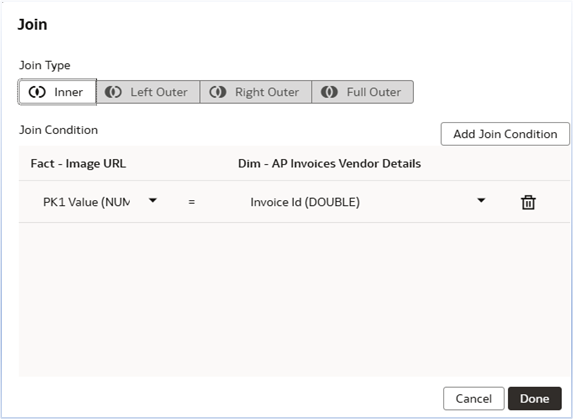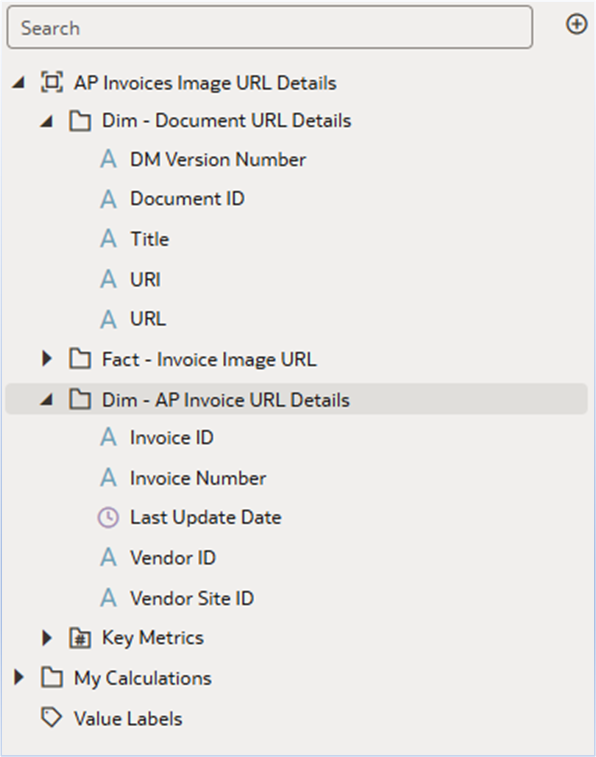Use Case
In financial workflows, especially in Accounts Payable (AP), users often need to validate invoices by checking supporting documents like scanned copies, payment proofs, or contracts. However, attachment URLs are not readily available in prebuilt FDI subject areas.
Oracle Fusion Data Intelligence (FDI) enables this through the Data Augmentation and Semantic Model Extension (SME) capabilities. This article demonstrates how to expose attachment URLs for AP invoices, allowing you to access document links directly from dashboards—reducing manual effort and improving traceability.
Prerequisites
- Access to FDI
- Ensure ‘SME Options for Data Augmentation’ is enabled.
- Required roles to access semantic model extension
- Knowledge of the PVOs involved:
- FndAttachedDocumentExtractPVO
- FndDocumentExtractPVO
- FndDocumentTranslationExtractPVO
Steps Summary
- Identify PVOs: Use the Fusion PVOs that expose document details
- Define join logic for AP invoice attachments
- Capture Fusion Domain details
- Create the Invoice Details view
- Augment Data: Use FDI’s Data Augmentation
- Create views using Augmented Tables
- Extend the semantic model – Create Logical Star and Custom subject area
- Publish and validate the subject area
1. Identify required PVOs
With Oracle Fusion Cloud Applications Release 25A, Oracle made the following PVOs available that allow access to document metadata and URLs:
HcmTopModelAnalyticsGlobalAM.HCMExtractAM.CommonBiccExtractAM.FndAttachedDocumentExtractPVO
HcmTopModelAnalyticsGlobalAM.HCMExtractAM.CommonBiccExtractAM.FndDocumentExtractPVO
HcmTopModelAnalyticsGlobalAM.HCMExtractAM.CommonBiccExtractAM.FndDocumentTranslationExtractPVO
These PVOs correspond to Fusion application tables:
| PVO |
Application Table |
| FndAttachedDocumentExtractPVO |
FND_ATTACHED_DOCUMENTS |
| FndDocumentExtractPVO |
FND_DOCUMENTS |
| FndDocumentTranslationExtractPVO |
FND_DOCUMENTS_TL |
By joining these three PVOs, you can construct a complete view of the attachments, including the attachments URL.
2. Define join logic for AP invoice attachments
To limit the scope to AP invoice attachments, use the following logic:
FndAttachedDocumentExtractPVO.ENTITY_NAME = ‘AP_INVOICES’
FndAttachedDocumentExtractPVO.PK1_VALUE = AP_INVOICES_ALL.INVOICE_ID
Join relationships between the PVOs are:
FndAttachedDocumentExtractPVO.DOCUMENT_ID = FndDocumentExtractPVO.DOCUMENT_ID
FndDocumentExtractPVO.DOCUMENT_ID = FndDocumentTranslationExtractPVO.DOCUMENT_ID
These relationships map metadata like file name, title, creation date, and most importantly, the document access URL.
3. Capture Fusion Domain details
In Oracle Fusion Cloud Applications, domain information is stored in the internal table fusion.ask_deployed_domains, so custom data capture table is created in the ADW and manually inserted the required domain details into it.
Table name: DW_FA_X_FUSION_DEPLOYED_DOMAINS
This table stores essential domain metadata. This use case specifically uses the following column:
EXTERNAL_VIRTUAL_HOST — used to construct external-facing document links dynamically.
4. Create the Invoice Details View
The following view is created using the predefined ADW tables available in FDI. It joins invoice, supplier site, and party dimension tables to retrieve key attributes such as vendor ID, vendor site ID, and invoice number. This simplifies reporting and analysis related to supplier invoices.
CREATE OR REPLACE VIEW DW_FA_X_AP_INVOICE_VIEW AS
SELECT
inv.invoice_number AS invoice_number,
inv.invoice_id AS invoice_id,
site.supplier_id AS vendor_id,
site.supplier_site_id AS vendor_site_id
FROM
oax$oac.dw_ap_invoice_cf_sec inv
JOIN
oax$oac.dw_supplier_site_d site
ON inv.supplier_site_id = site.supplier_site_id
JOIN
oax$oac.dw_party_d party
ON site.party_id = party.party_id;
5. Augment Data: Use FDI’s Data Augmentation
Data Augmentation in FDI allows you to import additional data — beyond the default FDI subject areas — from Oracle Fusion Cloud Applications. This is especially useful when required analytics fields or tables exist in the underlying application but are not included in the pre-packaged model.
To support reporting on document metadata, begin by augmenting three predefined PVOs available in Oracle Fusion Applications.
FndAttachedDocumentExtractPVO→ Augmented asDW_FA_X_URL(used as the fact table)FndDocumentExtractPVO→ Augmented asDW_FA_X_DOC_URLFndDocumentTranslationExtractPVO→ Augmented asDW_FA_X_DOC_TL_URL
6. Create the views on augmented tables
A view named DW_FA_X_DOC_URL_DETAILS_V is then created by joining the two augmented dimension tables — DW_FA_X_DOC_URL and DW_FA_X_DOC_TL_URL.
CREATE OR REPLACE VIEW DW_FA_X_DOC_URL_DETAILS_V AS
SELECT
fdt.documentid,
fdt.url,
fdt.uri,
fdt.title,
fdt.dmversionnumber,
REPLACE(
REPLACE(
CASE
WHEN fdt.URL IS NOT NULL THEN fdt.URL
WHEN fdt.URI IS NOT NULL THEN
(SELECT external_virtual_host
FROM DW_FA_X_FUSION_DEPLOYED_DOMAINS
WHERE deployed_domain_name = ‘FADomain’) || fdt.URI
WHEN fdt.TITLE IS NOT NULL THEN
(SELECT external_virtual_host
FROM DW_FA_X_FUSION_DEPLOYED_DOMAINS
WHERE deployed_domain_name = ‘FADomain’) ||
‘/cs/idcplg?IdcService=GET_FILE=’ || fdt.DMVERSIONNUMBER
ELSE NULL
END,
‘<old_domain1>’, ‘<new_host>’
),
‘<old_domain2>’,
(SELECT external_virtual_host
FROM DW_FA_X_FUSION_DEPLOYED_DOMAINS
WHERE deployed_domain_name = ‘FADomain’)
) AS INVOICE_IMAGE_LINK
FROM
oax$oac.dw_fa_x_doc_url fd,
oax$oac.dw_fa_x_doc_tl_url fdt
WHERE
fd.documentid = fdt.documentid;
Together, these components form a data model for reporting on attached documents with relevant supplier and invoice attributes.
7. Extend the Semantic Model
Once invoice attachment data is ingested via data augmentation and views creation, the next task is to expose it through a semantic layer for analysis. This is achieved using the Semantic Model Extensions (SME) capability in FDI.
- Go to Semantic Model Extensions.
- Create a new sandbox and create a new logical star.
DW_FA_X_URLas the fact tableDW_FA_X_DOC_URL_DETAILS_Vas the first dimension for URL detailsDW_FA_X_AP_INVOICE_VIEWas the second dimension for vendor/invoice details
- Add new subject area; for example, AP Invoice Image URL Details.




After applying and publishing the sandbox created in earlier steps, you can navigate to the catalog and search for the custom subject area (for example, AP Invoices Image URL Details). Open it in the reporting tool and validate by checking:

Conclusion
By combining the Data Augmentation and Semantic Model Extensions capabilities, you can expose the AP Invoice attachment URLs in FDI. This approach is scalable, easy to maintain, and unlocks a new level of transparency and insight into invoice processing.
Call to Action
Refer to these resources:
Now that you’ve read this article, try it yourself and let us know your results in the Oracle Analytics Community, where you can also ask questions and post ideas. It’s free and easy to join!
